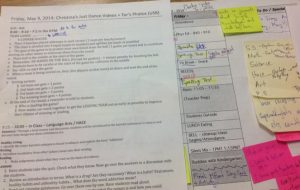
Teachers develop Dayplans and Weekplans to guide learning and to keep track of the schedule on a short-term basis. They are fluid documents that are revised as you teach. They are kept organized and understandable but are definitely ‘works in process’ that get a bit ‘marked up’! Many experienced teachers rely on week plans to guide the teaching and learning in the classroom.
Classroom teachers will also create year-long or year-at-a-glance plans as tools to support long-term planning (usually required by contract and requested annually by the school admin). (Here is a long term planning template shared by SD34)
Initially in practicum, you will likely keep a week-at-a-glance plan with detailed lesson plans (accompanied by associated unit plans) to support each teaching opportunity. The week plan may be your School Advisor’s (SA’s) plan. Over time, you will take on this responsibility and begin to develop your own Week and Day plans in consultation with your advisors. Your day plans will likely be more detailed than those of your more experienced SA. More akin to what your SA might leave for a TTOC (Teacher Teaching on Call)
Sample Day Plan Blank (elementary)
Your SA or Ts within your school are your best resource for sample day and week planning as they will often have templates with the specific schedule for the term, semester, quarter, etc.
Dayplans
You will likely adapt or create a template for each day of the week with some basic information in it already (so you don’t have to rewrite this each day):
- LST or other ‘scheduled’ non-enrolling teacher support (pull-out or work in class)
- Supervision
- Lunch routine? Attendance?
- Daily routines with brief description.
- Lesson brief – if a fully prep’d lesson plan is attached, simply note “See attached Lesson #”
- If no lesson plan, the brief should include learning intentions, notes about assessment, adaptations, materials, brief sequence or description that supports teaching (in the event you are away or in case your SA or school principal wishes to see evidence of short term planning)
NOTE: It is not uncommon, as the extended practicum progresses, for TCs to begin to shift from detailed individual lesson plans to day plans with somewhat less detail. Any shift from lesson planning to day planning and/or weekly planning templates needs to be considered carefully and in consultation with your FA and SA – with their explicit permission. Even when/if you do shift, constantly revisit how your teaching is going. If further detail is needed in your plans to support teaching and student learning – include it! If you are beginning a new unit or teaching something that is more complex or difficult for you, it is always helpful to design a complete a lesson plan. Be proactive in your planning. MORE is better as it will help you internalize the whole process.
Consider including the following in your Daybook (follow advice and guidelines from your FA and SA)
- a Practicum/School Calendar,
- 10 week Overview of Teaching,
- hard copies of all Unit plans,
- all Lesson plans (recommend organizing them week by week and adding to them as weeks progress)
- Week at a glance schedule (sent to FA weekly on Fridays for the following week)
- emergency preparedness plans/map,
- seating plan,
- Class list
- Dayplans (when appropriate – after midpoint for sure)
A few general guidelines:
- The daybook stays at the school.
- The daybook should be organized so that a TTOC (teacher teaching on call) can find what they need easily.
- Leave it open at your workspace to the current day/lesson/plan each evening before leaving school
- include all needed resources with it in an organized way (i.e. daily folder with any worksheets, books, templates etc)
*Ensure documents you leave on your desktop do not infringe on student privacy… The daybook should be separate from your organized assessment system which may go home with you and return to school each day (or stored securely at school).
